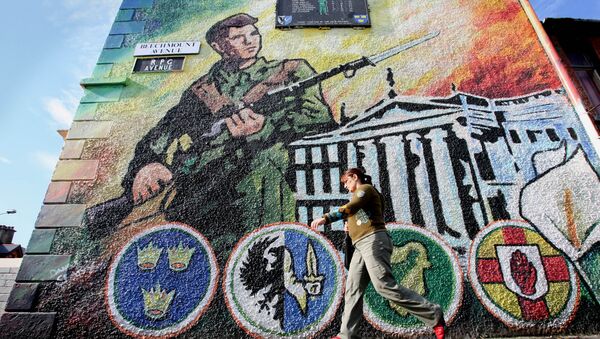The two biggest political parties in Northern Ireland reached an impasse on Wednesday, February 14, after weeks of talks about ending the stalemate.
Between 1969 and 1998 the Provisional IRA was engaged in a bitter battle with the British Army and loyalist paramilitaries, which ended with the signing of the Good Friday Agreement, which set up a power-sharing mechanism.
But the devolved government at Stormont has been in turmoil for 12 months with Sinn Fein, which was once the political wing of the IRA, and the Democratic Unionist Party (DUP) unable to agree on power-sharing.
Originally Sinn Fein had demanded DUP leader Arlene Foster go, because of her role in a botched green energy scheme which cost taxpayers millions of pounds. But the recent negotiations have stumbled over the DUP's unwillingness to accept the Irish Language Act, which would have given the Irish language equal standing with English in Northern Ireland.
"Most people do not want to go back to war," Graham Dawson, a professor of historical cultural studies at the University of Brighton, told Sputnik.
29 July 2013: A senior judge ruled Michael Stone must serve the remainder of his 30 year term for Milltown killings pic.twitter.com/07poQj6om4
— ConflictNI (@ConflictNI) 30 July 2017
A Brutal Month
The month of March 1988 was one of the most brutal and momentous in the conflict.
On March 6, 1988 three IRA terrorists — Daniel McCann, Mairead Farrell and Sean Savage — were shot dead by an SAS unit in the British colony of Gibraltar.
It later emerged the trio had been unarmed and were not in possession of a viable bomb.
"The events of March 6 are fundamental. That political context is crucial to understanding the atmosphere at the time," Professor Graham Dawson told Sputnik.
Maverick Loyalist Gunman
Suddenly a lone loyalist gunman lobbed grenades into the crowd of mourners, who included Sinn Fein leader Gerry Adams.
Three people were killed — one of them an IRA man, Kevin Brady — and 60 injured.
"The policing of IRA funerals was usually very heavy and intrusive and there had been negotiations between Sinn Fein and the police and an understanding (that there would not be the usual IRA color party firing shots into the air at the graveside)," Professor Dawson told Sputnik.
The Milltown massacre, as it became known, ramped up the tension in Belfast even more.
Three days later Brady's funeral cortege was moving slowly down the Andersonstown Road, a staunchly republican area of west Belfast, when a car appeared with two men in it.
The crowd attacked the pair, who were armed, and dragged them out of the car, handing them over to an IRA gang who beat them and finished them off with gunshots in Casement Park.
British Soldiers Had 'Got Lost'
It later transpired the two men were British soldiers. Corporal David Howes and Corporal Derek Wood were from the Royal Corps of Signals.
"He didn't cry out, just looked at us with terrified eyes, as though we were all enemies in a foreign country who wouldn't have understood what language he was speaking if he called out for help," said journalist Mary Holland, an eyewitness who described what one of the men looked like as the mob closed in on him.
The official version of events was that Corporal Howes and his colleague were driving between two British Army bases on unrelated business, had been unaware of the funeral and had just got lost.
"There is a lot that is not known yet not just about the corporals but about a lot of incidents in The Troubles. It is deliberately concealed, a lot of secrecy and lying, misinformation and concealment," Professor Dawson told Sputnik.
The Milltown gunman, Michael Stone, was chased by the crowd and badly beaten before the police intervened and arrested him.
Cemetery Gunman Freed To Wreak Havoc
He was later jailed, only to be freed after the Good Friday Agreement in 1998.
Stone, then 51, hit the headlines again in 2006 when he tried to kill Martin McGuinness and other Sinn Féin leaders at Stormont.
He was thrown back in jail and in 2013 was told he must spend another 18 years in jail for the Milltown attack and three other sectarian murders he committed during The Troubles.
No Mechanism to 'Deal With the Past'
Professor Dawson said one of the flaws of the Good Friday Agreement was that there had been no mechanism to deal with getting to the bottom of what happened with key incidents like Gibraltar, Milltown and the killing of the corporals.
"There was a set of measures to create a political settlement that was going to be acceptable but no provision for ‘dealing with the past'. There was no Truth and Reconciliation Commission like in South Africa and so everything is being dealt with piecemeal," Professor Dawson told Sputnik.
"The events of March 1988 didn't themselves change the dynamic, they just deepened it," Professor Dawson told Sputnik.
He said there were around 100 killings in Northern Ireland in 1988 and in October of that year the British government took the extraordinary step of banning Gerry Adams and other voice from being broadcast, forcing broadcasters to employ actors to re-record his soundbites, so they could be dubbed.
The views and opinions expressed by Graham Dawson are those of the speaker and do not necessarily reflect those of Sputnik.




